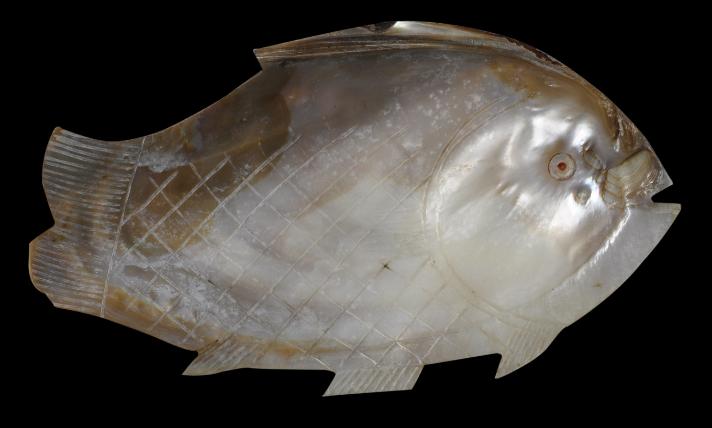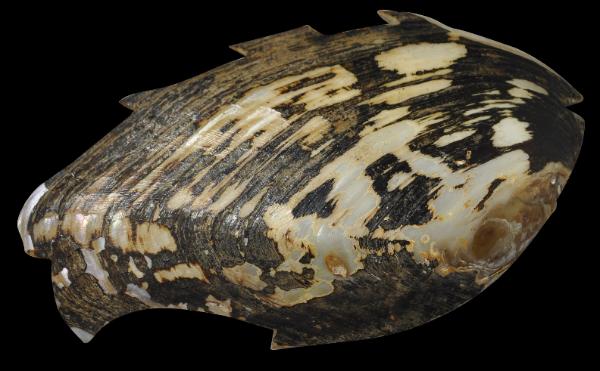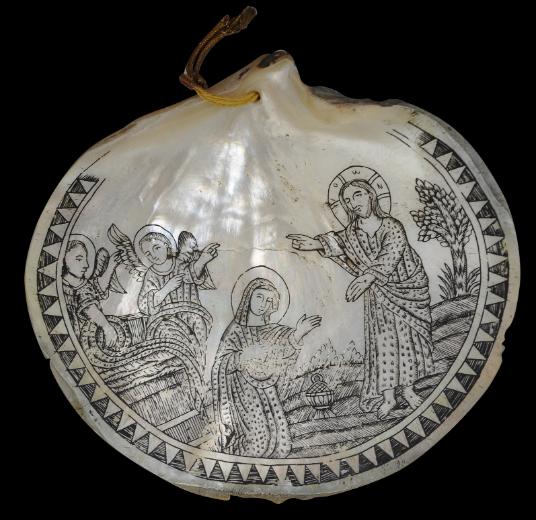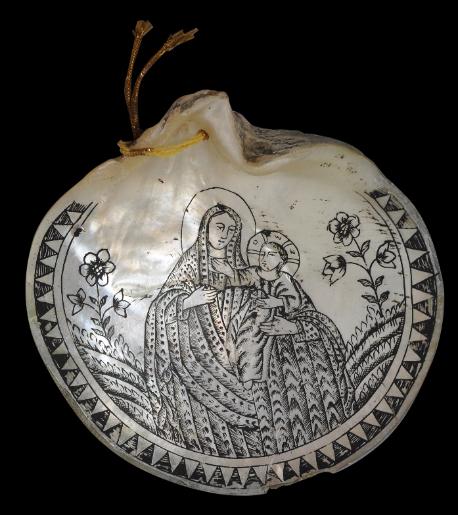
Colonial Philippines Baptismal Shells
Rare Set of Engraved Baptismal Shells
Spanish Colonial Philippines
17th-18th century
width of biggest shell: 16cm, width of smaller shell: 12.5cm; length of mussel shell: 17cm
These three shells most probably are from colonial Philippines and date to the seventeenth or eighteenth centuries. They would have been used at a baptismal font to scoop up water for poring over an infant’s heading during the baptismal ceremony. Each of the shells is large and of tropical waters: two are stripy mother-of-pearl shells and the third is a giant mussel shell.
The use of shells has obvious connotations with water and life. One of the shells, the mussel shell, is shaped as a fish, a further reference to life and no doubt also an allusion to Jesus and his Disciples as the ‘fishers of men’.
The two mother-of-pearl shells are engraved with scenes from the narrative of Jesus’ life.
The smaller shows him as an infant with Mary. Lillies, the emblematic flower of Mary, are on either side. The halo above the infant Jesus is engraved with the letters ‘O.W.N.’ The dress of both figures is particularly elaborate and decorated in the way that often is the case among colonial representations of the Holy Family.
The larger shell is engraved with the resurrected Jesus revealing himself to Mary in the presence of two angels.
The third shell, a mussel shell has been carved as a fish, as mentioned. It is engraved with an eye and scales, but unlike the other two, the engraving has not been coloured with lac.
Baptismal shells from the colonial Philippines are rare. There are only a few published examples and their attribution sometimes has become obscured. But there is a pre-Christian tradition of taking large mother-of-pearl shells in the Philippines, engraving them and then highlighting that engraving with lac. The Bontoc people of .central Luzon island, the Philippines, traditionally wore hip ornaments of shells engraved with geometric designs that were highlighted with dark ochres and the like. It seems that Spanish missionaries adapted this tradition by having baptismal shells made.
See Morales (2004, p. 313) for two plaques comprising engraved mother-of-pearl tiles attached to a wooden base showing two of the fourteen Stations of the Cross and which are in the Monasterio de Nuestra Senora de la Piedad in Cadiz, Spain. A Philippines’ attribution is suggested as is a second-half of the eighteenth century dating. The engraving work is very similar to that shown on the shells here. It too is darkened with lac or a similar substance.
A similar baptismal shell to the examples here but engraved with a traditional Ecce Homo scene amid similar foliage, is illustrated in Sierra de la Calle (2004, p. 21). This example is attributed to the eighteenth century Philippines.
The shells here are in fine condition. There are no breaks, cracks or repairs – merely sum fritting around the edges. The engraving work is crisp and clear.
References
Casal, G. et al, The People and Art of the Philippines, UCLA Museum of Cultural History, 1981.
Morales, A.J.
et al, Filipinas: Puerta de Oriente de Legazpi a Malaspina, SEACEX, 2004.
Sierra de la Calle, B.,
Filipinas: Obras Selectas del Museo Oriental, Museo Oriental, 2004.
Provenance
UK art market
Inventory no.: 2145
SOLD







